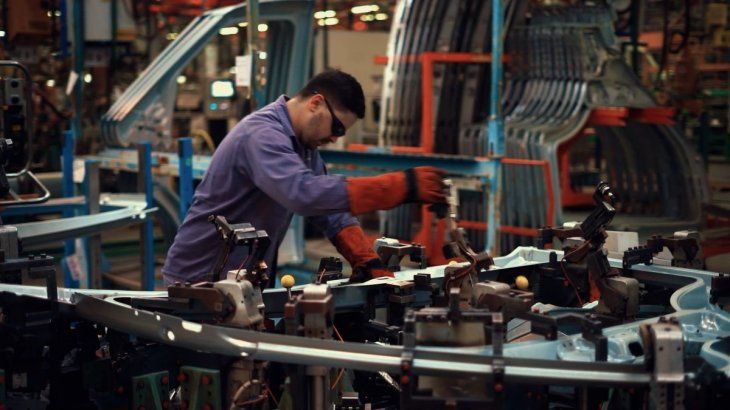Yerba mate production also maintains solid performance in the interannual comparison, with 17 consecutive months of increases. “However, signs of exhaustion begin to appear due to an increasingly higher comparison base: in August, the monthly variation was negative,” they explained.
Similarly, dairy farming prolongs its good times. “In August, 1,090,445,698 liters were obtained, a historical maximum, 18% above August 2024 and 8% more than in July. In the accumulated period from January to August, the volume was 12% higher than that of the same period in 2024,” they detailed.
TRACTOR.jpg
Agricultural machinery is one of the hardest hit items within the industry linked to the countryside.
However, he also explained that several industrial sectors within agriculture experienced setbacks. For example, the business chamber highlighted that “After the good performance in July, meat production fell and stood at 270.8 thousand tonswhich implies a drop of 20 thousand compared to the previous month and 10 thousand compared to August 2024.”
Domestic wine marketing also fell, with a decline of 17.2% year-on-year, although it advanced 2.9% compared to July. Foreign sales also suffered declines, with a red 16.5% compared to August 2024. For its part, in wheat milling there was an interannual drop of 6.4%, as a result of the drop in wheat production for breadwhich “fell sharply compared to July (-48 million tons).”
In turn, the production of agricultural machinery fell sharply in both comparisons: 12% year-on-year and 14% monthly. As a consequence, the sector reached the lowest level in the last six months.
The critical situation in the industry
In its latest report, the consulting firm Vector explained that in the real economy “the signs of deterioration are clearly manifested and there does not seem to be any an indicator or variable that, starting the second half of the year, shows positive signals“. In this sense, they highlighted the constant drop in the use of installed capacity in the industry, which is at historically low levels.
They stated that “this dynamic no longer seems to respond to current factors, but rather constitutes an unequivocal sign of the national government’s economic program, which deliberately not industrial focusedbut, on the contrary, has prioritized macroeconomic objectives (disinflation based on appreciating the exchange rate and import opening) that sacrifice manufacturing productive activity“.
On this point, they mentioned that “the automotive, food, publishing and printing, and paper and cardboard industries show minimal increases that fail to compensate for the generalized deterioration.” For their part, they clarified that although oil refining “emerges as the notable exception”showing an interannual growth of 4.9% in August, according to Indec, “Its performance unanchored from the national economic cycle positions it as an isolated case that does not reflect the reality of the rest of manufacturing activity.“.
And they added that “this sectoral configuration reveals a productive fabric that is stagnant on average, where progress is punctual or weak, while falls are significant.” For its part, Spotorno acknowledged to this medium that “the industry has a very dramatic change of context”a situation that “requires modifications, structural changes and also investments“.
In a complementary way, the economist Agustina Monti explained to Scope that exchange rate volatility does not play in the sector’s favor either: “The fact that you never know how much the dollar will be at does not allow you to planeven in the short term it is difficult, because you don’t know when to buy supplies. “Much of our industry has fully dollarized inputs.”
In addition, he commented that SMEs “to finance their working capital today have a very complicated time with the level of rates, it is almost impossible.” On Tuesday of last week, The interest rate on loans for current account advances reached 190%, a record since 2009.
Photo Industrial Center

Most branches of industry suffer widespread declines.
Weak signs of construction
When consulted about the construction sector, Spotorno considered that “it is a sector that is recovering very slowly”, as a result of “He has peculiarities that are holding him backespecially the issue of excess inventory in the real estate sector.” And he detailed: “More properties are being sold, but there are many properties built unsold. That means there are no incentives to build. Construction cost also plays a role“.
In August, the construction cost index in Greater Buenos Aires showed an increase of 3.2%, while activity showed an interannual variation of 0.4% and a monthly increase of 0.5%. This is a trend that would continue in September. The Construya Index, which measures the evolution of volumes sold to the private sector, registered a monthly increase of 1.08% and an increase of 6.5% compared to the same month last year.
For his part, Monti brought up a difference compared to last year’s situation: expectations. “Both the construction sector and the industrial sector, It was glimpsed that eventually 2025 was going to be a better yearand since it was not, expectations are negative, that does not help this to be reactivated either,” he argued.
Consumption, trade and imports
Spotorno considered that commerce “has been hit” as a result of construction scenariosbut above all in the industry, a factor to which he added “a change in relative prices that completely alters the spending structure of households”.
In this sense, SME retail sales fell 4.2% year-on-year in September and 2% in the monthly measurement, although they remain 5% above last year’s accumulated figure, according to CAME. “It traces a trajectory that begins in crisis, goes through a fleeting recovery and ends again in decline, evidencing the structural fragility of domestic demand“Vectorial commented on the data.
In this sense, they stressed that “as local production contracts and retail consumption fallsimports experience significant growth in items linked to final goods”, which results in a “vicious circle” for the economy. “Lower local production generates unemployment and a drop in income, which in turn reduces the demand for national products and reinforces the option for imports.“, they concluded.
Source: Ambito




